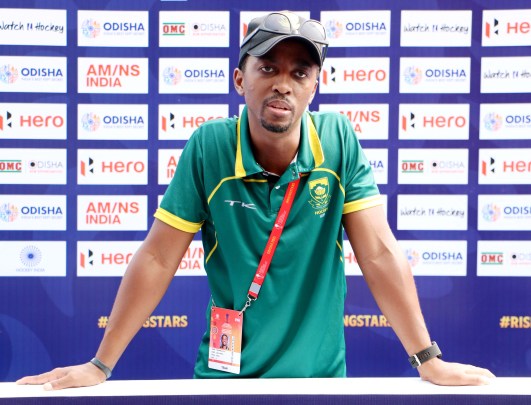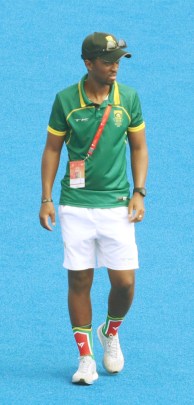Called ‘Mowgli’ during playing days, South Africa’s first black coach Siphesihle Ntuli making mark in ‘white man’s sport’
For a sport that has been accused of having an endemic race issue, Ntuli’s presence in the dug-out is a statement of breaking the glass ceiling.
 “You can't help but see the colour. And I think we should embrace it," says Ntuli, the face of change.
“You can't help but see the colour. And I think we should embrace it," says Ntuli, the face of change.Siphesihle Ntuli wishes the world was colourblind. But he is also a realist. “You can’t help but see it, it’s very obvious.”
It really is.
Ntuli is the first black chief coach of the South African men’s hockey team, and at present the only one among major international teams across senior and junior male programmes. “It’s not something that I consciously think about,” the 32-year-old, who was South Africa’s assistant coach at the Tokyo Olympics, says. “I know I belong here.”
For a sport that has been accused of having an endemic race issue, Ntuli’s presence in the dug-out is a statement of breaking the glass ceiling. Hockey’s diversity problems, which rarely got spoken off, were catapulted into the mainstream debate during the peak of the Black Lives Matter movement when the picture of England under-21 player Darcy Bourne – face partially covered, looking into the camera and holding up a board that read ‘Why is ending racism a debate?’ – went viral after it was shared by the son of Martin Luther King Jr.
“There are a limited number of black role models in hockey. As a young person, without meaning to, you do look up to people who look similar to you. In hockey I didn’t have that,” Bourne had said.
 Ntuli’s presence in the dug-out is a statement of breaking the glass ceiling.
Ntuli’s presence in the dug-out is a statement of breaking the glass ceiling.
Triggering a debate
Bourne’s actions triggered a debate across the hockey world. In England, according to The Guardian, the South Asians involved in the sport urged the country’s hockey body “to tackle a culture where talented black, Asian and minority ethnic players are ‘scared’ to report racism for fear it might affect their chances of progressing up the ladder.”
Hockey Australia, while stating their support for the reconciliation movement with the ethnic minorities, recognised ‘the unacceptable treatment of and racism towards Indigenous people’.
And in the Netherlands, Terrance Pieters, the first black player to play for the national team had an ‘emotional discussion’ with his teammates, revealing that he was wounded by the ‘hurtful words’.
“Hockey calls itself diverse, but it doesn’t mean there is no racism. As a player from Almere (a city in the Netherlands), I was constantly called ‘Mowgli’ during a match, every time I got the ball. I dared not say anything about it. I was so startled that I stiffened,” Pieters, who has a Surinamese mother and an Indian father, was quoted as saying in the Dutch media. “I came to a club, people said, ‘oh, you don’t see that often’. Or if I said I was a hockey player: ‘You? Do you play hockey?’ I thought: why not? Somebody pointed to a football field and said, ‘You must be there.’”
 In his prime, Ntuli suffered a lower back injury that abruptly ended his career, forcing him to turn to coaching.
In his prime, Ntuli suffered a lower back injury that abruptly ended his career, forcing him to turn to coaching.‘White man’s sport’
Ntuli had similar hurdles to cross in South Africa, where the distinction was unmistakable. “In the past, hockey was most likely regarded as a white man’s sport… (So) it does come with a sense of, ‘do I belong to this sport?’” By now, it’s something he is getting ‘used to’, being first a player and now a coach in a sport that is ‘quite white-dominated.’
But in a diverse country like South Africa, with its complex social problems, it’s not always easy. “In Langa, if you don’t play sport, you get involved in the streets,” says South Africa U-21 midfielder Zenani Kraai. “What happens in the streets is there’s ‘gangsterism’ and all that stuff. I didn’t want to get involved in that, so I mixed myself with sports. I used to play soccer, play cricket, but then I played hockey.”
Langa, a township in Cape Town, has a rich hockey tradition, the seeds of which were sown by the late cricket coach Bob Woolmer. But the pathways for players from the townships – the segregated, under-developed urban areas where a majority of the black and coloured population live – aren’t the same as those from other parts of the country.
Hockey, in South Africa, is self-funded, meaning the players have to bear their own expenses even while playing for the national team. Then, they have to struggle to get access to a hockey field, then battle the racial stereotypes before weaving their way past tricky selection criteria and spend playing career winning the trust of their teammates, proving to them that they actually belong there and aren’t just in the team because of the quota rules.
Cricket and rugby, two of the biggest sports in South Africa, have largely dominated the conversation about racial transformation, which lays specific focus on increasing black representation. There has been some tangible change in both those sports but hockey, for a long time, had remained on the fringes.
At forefront of transformation
Ntuli has been at the forefront of the transformation. After battling prejudice having grown up in townships in Durban and Pretoria, he became part of one of the first generations of black players that played for the national team. In his prime, however, he suffered a lower back injury that abruptly ended his career, forcing him to turn to coaching.
Managing the dugout in a sport where there are very few non-white coaches, Ntuli is now trying to overcome perception battles of a different kind. But he is comfortable in his skin. “It’s not a pressure thing for me. I am very confident in my ability. It’s not about proving anything to anyone,” he says. “How people view our team and what it looks like, I can’t control that. But I am very proud that as a Black African male, I am representing a large group back home that possibly never thought that it was possible for someone like me to be the head coach of a national team.”
It’s already inspiring the younger generations. “It shows me that everything is possible as long as you have a vision,” Kraai says.
Kraai is one of the half-a-dozen coloured players in the South African team here in Bhubaneswar, a departure from the past where there would be just one or two coloured players. Perhaps, it’s just a coincidence that this transformation comes when Ntuli is at the helm. The make-up of this team, the coach stresses, is a clear indication that hockey ‘no longer belongs to elite few in South Africa.’
“We are trying to get everyone involved, not like the olden times. As long as you are working hard, you can make the team no matter what the skin colour,” Kraai says. “It’s changing.”
And Ntuli is the face of that change. “You can’t help but see the colour,” he says. “And I think we should embrace it.”
































